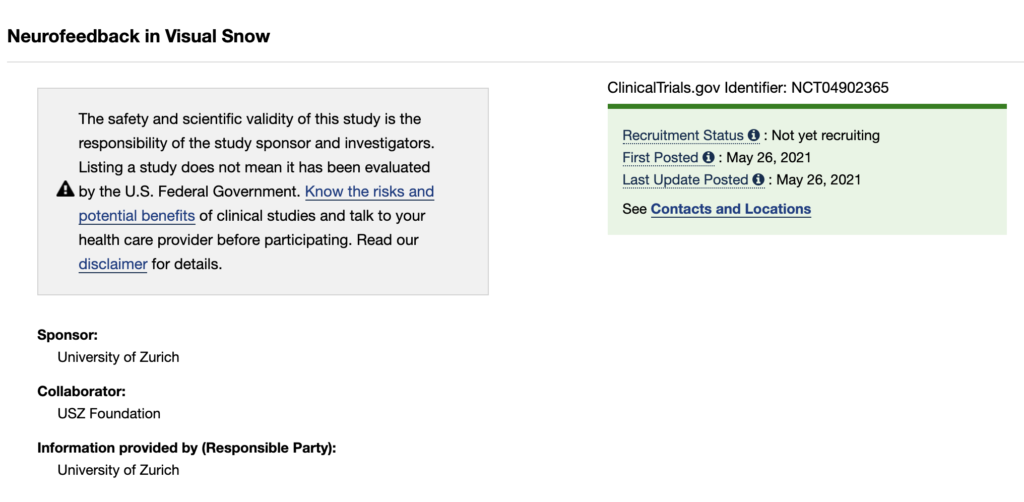Some good news:
A new clinical trial for visual snow syndrome was added to the clinicaltrials.gov database earlier today.
 This is the second ever VS study added to the system. But unlike the first study we covered, this one has nothing to do with mindfulness and cognitive behavioral therapy.
This is the second ever VS study added to the system. But unlike the first study we covered, this one has nothing to do with mindfulness and cognitive behavioral therapy.
Instead it focuses on giving patients a way to reduce the actual visual snow intensity and prevalence.
The study is titled, “Neurofeedback for Patients With Visual Snow” and it is expected to start in just over a month from now, on July 1, 2021. Currently not yet recruiting, but that status should change soon.
A total of 70 participants will be enrolled.
The study is taking place at the University of Zurich. It is funded by the USZ Foundation.
In a double-blind, randomized and placebo-controlled longitudinal experiment, we will use real-time functional magnetic resonance imaging (rtfMRI) neurofeedback to teach patients to downregulate activity in different regions of the visual cortex
Here is a brief summary, from the study description:
Visual snow (VS) is a distressing, life-impacting condition with unrelenting and persistent disturbing visual phenomena. Disease onset is usually around age 20 and is characterized by continuous perception of innumerable flickering dots (like a ‘broken television’). The disease is often accompanied by comorbidities such as migraine, tinnitus, depression and anxiety.
Neuronally, VS patients show cerebral hypermetabolism, resulting in altered neuronal excitability, as well as increased grey matter volume in parts of the visual cortex.
For this pilot study, we aim to recruit VS patients. In a double-blind, randomized and placebo-controlled longitudinal experiment, we will use real-time functional magnetic resonance imaging (rtfMRI) neurofeedback to teach patients to downregulate activity in different regions of the visual cortex.
We hypothesize that neurofeedback will allow patients to learn to downregulate their abnormal visual cortex activity. Moreover, we predict a stronger downregulation of activity from the lingual gyrus will correlate with a more pronounced decrease in VS symptoms.
Here is a link to the official study record:
https://clinicaltrials.gov/ct2/show/NCT04902365
That’s all for now.
Important:
This article is an early draft. You are able to access it because you (or someone who shared this link) is subscribed to Visual Snow Treatment Report email updates. Not subscribed? Sign up here. It’s free. Expect between 1-2 emails per week. But only if something new is happening. No spam, no promotional emails. Only goodies like this. Your information is kept private and never shared with third parties.
Already subscribed? Tell a friend or share this article if you know anyone who might find it helpful.
Questions? Feedback? Comments? Send an email to michael@urgentresearch.com and say hello.